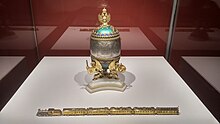| Trans-Siberian Railway Fabergé egg | |
|---|---|
 The Trans-Siberian Railway Egg photographed in the Kremlin in 2020 The Trans-Siberian Railway Egg photographed in the Kremlin in 2020 | |
| Year delivered | 1900 |
| Customer | Nicholas II |
| Recipient | Alexandra Fedorovna |
| Current owner | |
| Individual or institution | Kremlin Armoury |
| Year of acquisition | 1927 |
| Design and materials | |
| Workmaster | Michael Perkhin |
| Materials used | Gold; silver; green, blue, and orange enamel; onyx; and velvet for lining |
| Height | 260 millimetres (10 in) |
| Surprise | Miniature train made of gold, platinum, rose-cut diamonds, rubies, and rock crystal |
The Trans-Siberian Railway egg is a jewelled Easter egg made under the supervision of the Russian jeweller Peter Carl Fabergé in 1900 for Tsar Nicholas II of Russia. The Fabergé egg was presented by Nicolas II as an Easter gift to his wife, the Tsarina Alexandra Fyodorovna. It is currently held in the Kremlin Armoury Museum in Moscow.
Design
The exterior of the 1900 Trans-Siberian Railway egg is made of onyx, silver, gold, and quartz, and is decorated with colored vitreous enamel. The lid of the egg is hinged, has an overlay of green enamel, and is decorated with inlaid leaves of acanthus. On top of the lid is a golden three-headed eagle in gold with the Imperial Crown. The interior is lined with velvet.
A route map of the Trans-Siberian Railway is engraved in silver across the face, with major stations marked by a precious stone, forming a belt around the egg. The egg is supported by three griffins made of gold-plated silver on a stepped triangular base of white onyx.
Surprise
The surprise is a miniature clockwork replica of a steam train made of gold and platinum in three sections, with an overall length of one foot. It has a diamond headlight, and ruby marker lights. The five carriages have rock crystal windows and are labeled “mail”, “ladies only”, “smoking”, “non-smoking” and “chapel”. The train has a gold key that can be used to wind it up and make it run.
History
In 1900, the railway linking European Russia with Vladivostok on Russia’s Pacific coast was nearing completion. This was an accomplishment that, despite its tremendous cost in resources and human lives, brought Nicholas great satisfaction since, as Tsarevitch, he had travelled to the Far East to lay the eastern foundation stone.
See also
References
- Faber, Toby (2008). Faberge's Eggs: The Extraordinary Story of the Masterpieces That Outlived an Empire. Random House. ISBN 978-1-4000-6550-9.
- Forbes, Christopher; Prinz von Hohenzollern, Johann Georg (1990). FABERGE; The Imperial Eggs. Prestel. ASIN B000YA9GOM.
- Lowes, Will (2001). Fabergé Eggs: A Retrospective Encyclopedia. Scarecrow Press. ISBN 0-8108-3946-6.
- Snowman, A Kenneth (1988). Carl Faberge: Goldsmith to the Imperial Court of Russia. Gramercy. ISBN 0-517-40502-4.